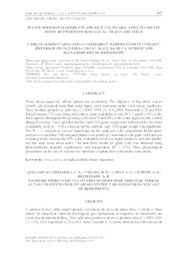Water stress in modern upland rice cultivars: a multivariate study between physiological traits and yield.
Water stress in modern upland rice cultivars: a multivariate study between physiological traits and yield.
Author(s): QUILOANGO-CHIMARRO, C. A.; COELHO, R. D.; COSTA, J. de O.; GUNDIM, A. da S.; HEINEMANN, A. B.
Summary: Water stress negatively affects upland rice production. The objective of this study was to identify physiological traits that could depict yield responses under water stress conditions. Three modern upland rice cultivars (C): BRS A501 CL (C1), BRS Esmeralda (C2) and BRS Serra Dourada (C3) were subjected to three water availability levels (W): Control (100% of the field capacity throughout the growing cycle) and 70 and 40% of the water applied to the control during flowering. Yield, spikelet sterility, and 1000-grain weight were influenced by the water availability level (p < 0.05), whereas for the cultivar, only 1000-grain weight was significant. The W × C interaction was not significant for the analyzed yield components. Multivariate analysis revealed that well-irrigated plants were positively associated with grain yield and gas exchange traits, whereas the 40% water availability level was highly related to spikelet sterility and the crop water stress index. The best-fitted model for grain yield was obtained using photosynthesis, stomatal conductance, and transpiration (R2 = 0.76). Thus, physiological parameters can be used to explain the variations in upland rice yield under water stress.
Publication year: 2023
Types of publication: Journal article
Unit: Embrapa Rice & Beans
Keywords: Arroz, Drought, Multiple linear regression, Oryza Sativa, Regression analysis, Regressão Linear, Rice, Seca, Stress, Água
Observation
Some of Embrapa's publications are published as ePub files. To read them, use or download one of the following free software options to your computer or mobile device. Android: Google Play Books; IOS: iBooks; Windows and Linux: Calibre.
Access other publications
Access the Agricultural Research Database (BDPA) to consult Embrapa's full library collection and records.
Visit Embrapa Bookstore to purchase books and other publications sold by Embrapa.

